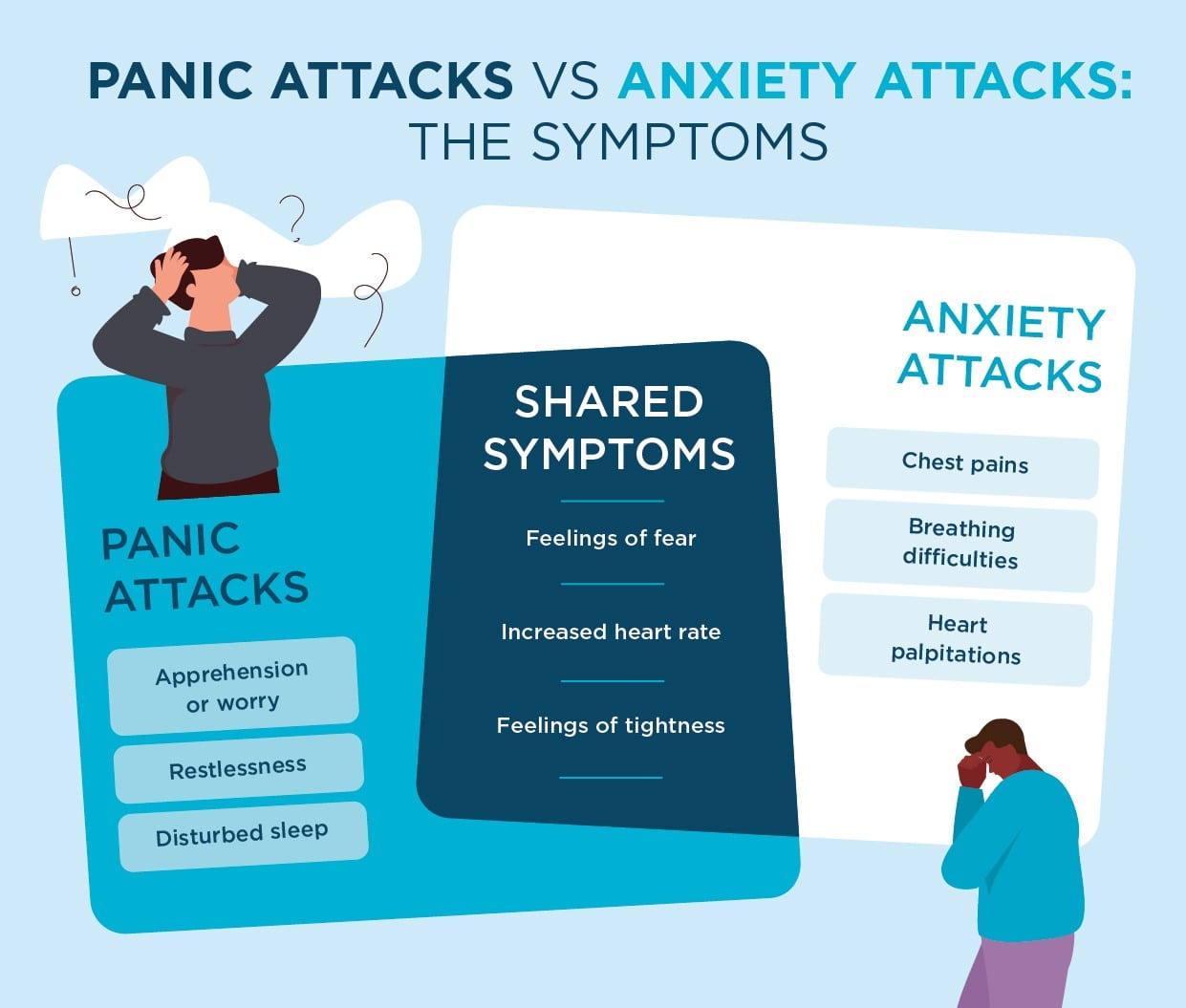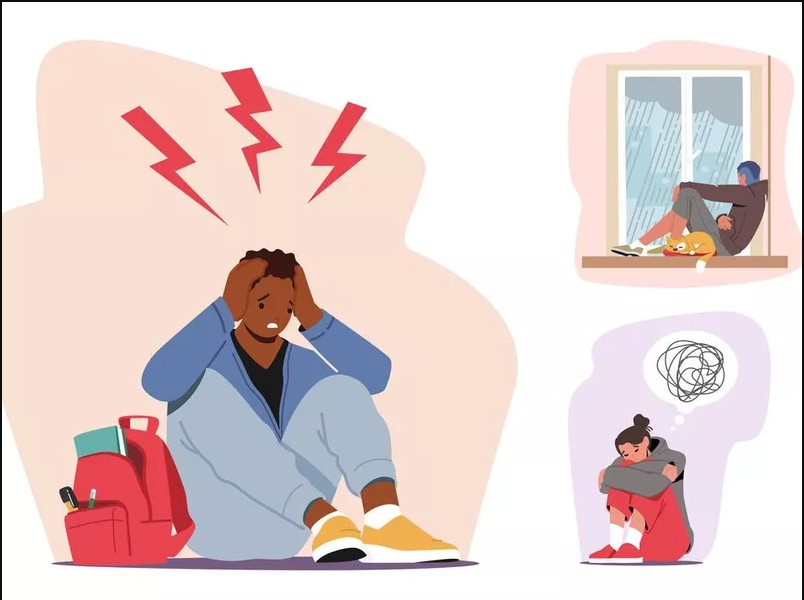Introduction to Anxiety and Panic Attacks
Anxiety and panic attacks are common mental health issues that affect millions of people worldwide. These conditions can be debilitating and have a significant impact on a person’s daily life. It is crucial to understand and manage anxiety and panic attacks to improve overall well-being and quality of life. Managing anxiety and panic attacks is essential because these conditions can interfere with daily activities, relationships, and overall happiness. When left untreated, anxiety and panic attacks can worsen over time and lead to more severe mental health issues such as depression. By learning effective coping strategies and seeking professional help when needed, individuals can regain control over their lives and reduce the impact of anxiety and panic attacks.
Understanding Anxiety and Panic Attacks
Anxiety is a normal human emotion that everyone experiences from time to time. However, when anxiety becomes excessive, uncontrollable, and interferes with daily life, it may be classified as an anxiety disorder. Panic attacks, on the other hand, are sudden episodes of intense fear or discomfort that reach their peak within minutes. They are often accompanied by physical symptoms such as a rapid heartbeat, shortness of breath, and chest pain.
The causes of anxiety and panic attacks can vary from person to person. Some common factors include genetics, brain chemistry, personality traits, and traumatic life events. Additionally, certain medical conditions and substance abuse can also contribute to the development of anxiety disorders.
There are several types of anxiety disorders, including generalized anxiety disorder (GAD), panic disorder, social anxiety disorder, specific phobias, and post-traumatic stress disorder (PTSD). Each type has its own set of symptoms and triggers, making it important to identify the specific type of anxiety disorder in order to develop an effective treatment plan.
Common Triggers of Anxiety and Panic Attacks
Anxiety and panic attacks can be triggered by various factors. These triggers can be categorized into environmental, social, psychological, and physical triggers.
Environmental triggers refer to external factors in a person’s surroundings that can induce anxiety or panic. Examples include crowded places, loud noises, or unfamiliar environments. Social triggers involve situations that involve interacting with others, such as public speaking or attending social events. Psychological triggers are related to thoughts, memories, or beliefs that can cause anxiety or panic. These triggers can be specific to an individual and may include certain phobias or traumatic experiences. Lastly, physical triggers are related to bodily sensations or changes, such as a racing heart or shortness of breath, that can trigger anxiety or panic.
Identifying and understanding these triggers can help individuals better manage their anxiety and panic attacks. By avoiding or minimizing exposure to triggers, individuals can reduce the frequency and intensity of their symptoms.
Symptoms of Anxiety and Panic Attacks
Anxiety and panic attacks can manifest in various ways, including physical, emotional, and behavioral symptoms.
Physical symptoms of anxiety and panic attacks may include a rapid heartbeat, chest pain, shortness of breath, dizziness, sweating, trembling, and gastrointestinal issues. These physical symptoms can be distressing and may lead individuals to believe they are experiencing a medical emergency.
Emotional symptoms of anxiety and panic attacks can include feelings of fear, apprehension, irritability, restlessness, and a sense of impending doom. Individuals may also experience difficulty concentrating, feeling on edge, and having trouble sleeping.
Behavioral symptoms of anxiety and panic attacks may involve avoidance behaviors, such as avoiding certain situations or places that trigger anxiety. Individuals may also engage in repetitive behaviors or rituals as a way to cope with their anxiety.
It is important to note that symptoms can vary from person to person and may change over time. Recognizing these symptoms is crucial in order to seek appropriate help and develop effective coping strategies.
Coping Strategies for Anxiety and Panic Attacks
There are various coping strategies that can help individuals manage their anxiety and panic attacks. These strategies can be used in combination or individually, depending on the individual’s preferences and needs.
Relaxation techniques, such as deep breathing exercises, progressive muscle relaxation, and guided imagery, can help calm the body and mind during moments of anxiety or panic. Cognitive-behavioral therapy (CBT) is a widely used therapeutic approach that helps individuals identify and change negative thought patterns and behaviors associated with anxiety. Exposure therapy involves gradually exposing individuals to their fears or triggers in a controlled and safe environment, allowing them to build resilience and reduce anxiety over time.
Positive self-talk is another effective coping strategy that involves replacing negative thoughts with positive and affirming statements. Time management techniques, such as prioritizing tasks and setting realistic goals, can also help reduce stress and anxiety.
Breathing Techniques for Managing Anxiety and Panic Attacks
Breathing techniques are simple yet powerful tools for managing anxiety and panic attacks. By focusing on the breath, individuals can activate the body’s relaxation response and reduce the intensity of their symptoms.
Diaphragmatic breathing, also known as belly breathing, involves taking slow, deep breaths into the diaphragm rather than shallow breaths into the chest. This technique helps slow down the heart rate and promote relaxation.
Box breathing is a technique that involves inhaling for a count of four, holding the breath for a count of four, exhaling for a count of four, and holding the breath again for a count of four. This pattern is repeated several times, helping to regulate breathing and calm the mind.
Pursed-lip breathing involves inhaling slowly through the nose and exhaling through pursed lips as if blowing out a candle. This technique helps slow down breathing and reduce feelings of anxiety.
Equal breathing involves inhaling and exhaling for an equal count, such as inhaling for a count of four and exhaling for a count of four. This technique helps balance the breath and promote a sense of calm.
Mindfulness and Meditation for Anxiety and Panic Attacks
Mindfulness and meditation are practices that involve focusing one’s attention on the present moment without judgment. These practices have been shown to be effective in reducing anxiety and panic attacks.
Mindfulness involves paying attention to one’s thoughts, feelings, and bodily sensations in a non-judgmental way. By practicing mindfulness, individuals can become more aware of their anxiety triggers and learn to respond to them in a more calm and balanced manner.
Meditation involves sitting quietly and focusing on the breath or a specific object or mantra. This practice helps quiet the mind and reduce racing thoughts and worries. Regular meditation can help individuals develop a sense of inner peace and resilience in the face of anxiety.
There are various techniques for mindfulness and meditation, including guided meditations, body scans, walking meditations, and loving-kindness meditations. It is important to find a technique that resonates with the individual and to practice regularly for optimal benefits.
Exercise and Physical Activity for Anxiety and Panic Attacks
Exercise and physical activity have been shown to be effective in reducing anxiety and panic attacks. Engaging in regular exercise helps release endorphins, which are natural mood-boosting chemicals in the brain. Exercise also helps reduce muscle tension, improve sleep quality, and increase self-confidence.
There are various types of exercise that can be beneficial for anxiety and panic attacks. Aerobic exercises such as running, swimming, or cycling can help reduce anxiety symptoms by increasing heart rate and promoting the release of endorphins. Strength training exercises, such as weightlifting or yoga, can help improve overall physical strength and reduce muscle tension associated with anxiety.
Incorporating exercise into daily routine can be challenging, but it is important to start small and gradually increase intensity and duration. Finding activities that are enjoyable and engaging can also help individuals stay motivated and committed to regular exercise.
Nutrition and Diet for Managing Anxiety and Panic Attacks
Nutrition and diet play a significant role in managing anxiety and panic attacks. Certain foods and beverages can exacerbate anxiety symptoms, while others can help reduce them.
Foods to avoid include caffeine, alcohol, processed foods, and sugary snacks. These substances can increase heart rate, disrupt sleep, and contribute to feelings of anxiety. It is also important to limit or avoid foods high in trans fats and artificial additives, as they can negatively impact mood and overall well-being.
Foods to include in a diet for managing anxiety and panic attacks include whole grains, fruits, vegetables, lean proteins, and foods rich in omega-3 fatty acids. These foods provide essential nutrients that support brain health and help regulate mood. Additionally, incorporating probiotic-rich foods such as yogurt or sauerkraut can promote a healthy gut microbiome, which has been linked to improved mental health.
Supplements such as omega-3 fatty acids, magnesium, and B vitamins may also be beneficial for managing anxiety and panic attacks. However, it is important to consult with a healthcare professional before starting any new supplements to ensure safety and effectiveness.
Seeking Professional Help for Anxiety and Panic Attacks
While self-help strategies can be effective for managing anxiety and panic attacks, it is important to seek professional help when needed. Mental health professionals such as psychologists, psychiatrists, and therapists can provide guidance, support, and evidence-based treatments for anxiety disorders.
Treatment options for anxiety and panic attacks may include therapy, medication, or a combination of both. Cognitive-behavioral therapy (CBT) is a commonly used therapy that helps individuals identify and change negative thought patterns and behaviors associated with anxiety. Medications such as selective serotonin reuptake inhibitors (SSRIs) or benzodiazepines may be prescribed to help manage symptoms.
Finding a therapist or mental health professional can be done through recommendations from healthcare providers, online directories, or local mental health organizations. It is important to find a professional who specializes in anxiety disorders and with whom the individual feels comfortable and supported.
Self-Care and Lifestyle Changes for Managing Anxiety and Panic Attacks
Self-care and lifestyle changes are crucial for managing anxiety and panic attacks. Taking care of one’s physical, emotional, and mental well-being can help reduce stress and improve overall resilience.
Self-care practices may include engaging in activities that bring joy and relaxation, such as hobbies, spending time in nature, or practicing self-compassion. It is important to prioritize self-care activities and make time for them regularly.
Lifestyle changes that can help manage anxiety and panic attacks include maintaining a regular sleep schedule, practicing good sleep hygiene, and reducing exposure to stressful situations or triggers. It may also be helpful to establish a daily routine that includes time for self-care, exercise, and relaxation.
Conclusion:
Managing anxiety and panic attacks is essential for improving overall well-being and quality of life. By understanding the causes and triggers of anxiety, individuals can develop effective coping strategies and seek appropriate professional help when needed. Breathing techniques, mindfulness and meditation, exercise, nutrition, and self-care practices are all valuable tools for managing anxiety and panic attacks. It is important to remember that everyone’s journey is unique, and finding the right combination of strategies may take time. With patience, support, and a commitment to self-care, individuals can regain control over their lives and reduce the impact of anxiety and panic attacks.







